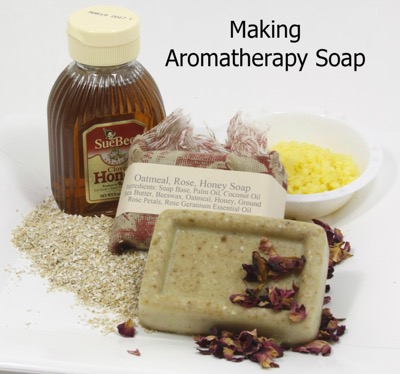Making soap at home using essential oils for soap lets you choose the scents you want and avoid ingredients you don’t want. This article describes options for making soaps, talks about how to choose essential oils, and points you to resources for detailed soap-making instructions.
Cold Process Soaps
To make cold process soaps, you combine a base oil containing fatty acids (almost any oil, from beef tallow to olive oil) with sodium hydroxide (lye).
Lye is a caustic substance that you must handle with extreme care using the appropriate safety precautions. However, no lye remains in the finished soap. Learn more about lye in soapmaking.
For cold process soaps, Cathy Winsby of Soap Making Essentials recommends 3 to 4 teaspoons (15 to 20 ml or 0.5 to 0.7 ounce) of essential oil for each pound of base oil. She notes some people use as much as one ounce of essential oil for each pound of base oil. However, that much essential oil creates a very strong scent that not everyone likes or can tolerate.
You want to add the essential oils near the end of the soap-making
process, after the lye has mostly evaporated. Lye can damage essential
oils.
Here’s a video on getting started making cold process soaps:
Hot Process Soaps
A variation of soapmaking is hot process soaps, where you heat all the ingredients to put the soap through various stages. When the excess water evaporates, the soap is ready to cool and then use. You add the essential oils at the cooling stage.
Here’s an introductory video:
Melt and Pour Soaps
The easiest way to make soap is to use melt and pour. You purchase a clear soap base, melt the blocks, add color (if desired) and essential oils, and place the melted mixture into molds to harden into solid soap. This approach is especially good if you want to get your children involved.
Recommended book: Easy Homemade Melt and Pour Soaps: A Modern Guide. It offers a range of recipes that create beautiful soaps. Here are a few of the book’s suggested essential oil blends for use in 16 ounces of melt and pour soap (for a 1{c83b96b267e11f12aa2387b40a42d69d65b4fa2fbc0f29beedb0c76e3b50b2dc} dilution that produces a light scent):
- 3/4 teaspoon (tsp.) bergamot + 1/4 tsp. rosemary
- 3/4 tsp. lavender + 1/2 tsp. peppermint
- 3/4 tsp. lavender + 1/4 tsp. patchouli
- 7/8 tsp. cedarwood + 1/8 tsp. clove bud + 1/8 tsp. vetiver
- 5/8 tsp. peppermint + 3/8 tsp. fir needle + 1/8 tsp. rosemary
Essential Oils for Soap
Which essential oils can you use in making aromatherapy soap? You can choose any oil that’s not irritating to your skin. It’s important to use only high-quality oils.
Popular Single Scents
Floral scents are popular: jasmine, lavender, neroli, rose, ylang ylang.
Citrus scents are also popular: grapefruit, lemon, orange, tangerine.
Earthy scents: frankincense, myrrh, patchouli, vetiver
Woodsy scents: cedarwood, sandalwood
Spicy scents: ginger, nutmeg
Resource: Making Soap Magazine
Essential Oil Blends for Soap
These blends are given in percentages so you can adjust the amount to the size of the batch of soap you’re making.
#1
60{c83b96b267e11f12aa2387b40a42d69d65b4fa2fbc0f29beedb0c76e3b50b2dc} rosemary essential oil
20{c83b96b267e11f12aa2387b40a42d69d65b4fa2fbc0f29beedb0c76e3b50b2dc} cedarwood essential oil
20{c83b96b267e11f12aa2387b40a42d69d65b4fa2fbc0f29beedb0c76e3b50b2dc} spearmint essential oil
#2
60{c83b96b267e11f12aa2387b40a42d69d65b4fa2fbc0f29beedb0c76e3b50b2dc} sweet orange essential oil
20{c83b96b267e11f12aa2387b40a42d69d65b4fa2fbc0f29beedb0c76e3b50b2dc} ginger essential oil
20{c83b96b267e11f12aa2387b40a42d69d65b4fa2fbc0f29beedb0c76e3b50b2dc} patchouli essential oil
Source: The Essential Oil Company
#3
30{c83b96b267e11f12aa2387b40a42d69d65b4fa2fbc0f29beedb0c76e3b50b2dc} clary sage essential oil
70{c83b96b267e11f12aa2387b40a42d69d65b4fa2fbc0f29beedb0c76e3b50b2dc} lemongrass essential oil
#4
50{c83b96b267e11f12aa2387b40a42d69d65b4fa2fbc0f29beedb0c76e3b50b2dc} lemon essential oil
33{c83b96b267e11f12aa2387b40a42d69d65b4fa2fbc0f29beedb0c76e3b50b2dc} lavender essential oil
17{c83b96b267e11f12aa2387b40a42d69d65b4fa2fbc0f29beedb0c76e3b50b2dc} may chang (Listea cubeba) essential oil
#5
50{c83b96b267e11f12aa2387b40a42d69d65b4fa2fbc0f29beedb0c76e3b50b2dc} peppermint essential oil
33{c83b96b267e11f12aa2387b40a42d69d65b4fa2fbc0f29beedb0c76e3b50b2dc} anise essential oil
17{c83b96b267e11f12aa2387b40a42d69d65b4fa2fbc0f29beedb0c76e3b50b2dc} vanilla oleoresin
Source: Lovin’ Soap Studio
#6
35{c83b96b267e11f12aa2387b40a42d69d65b4fa2fbc0f29beedb0c76e3b50b2dc} orange essential oil
25{c83b96b267e11f12aa2387b40a42d69d65b4fa2fbc0f29beedb0c76e3b50b2dc} rosemary essential oil
20{c83b96b267e11f12aa2387b40a42d69d65b4fa2fbc0f29beedb0c76e3b50b2dc} lavender essential oil
15{c83b96b267e11f12aa2387b40a42d69d65b4fa2fbc0f29beedb0c76e3b50b2dc} peppermint essential oil
5{c83b96b267e11f12aa2387b40a42d69d65b4fa2fbc0f29beedb0c76e3b50b2dc} may chang (Listea cubeba) essential oil
#7
35{c83b96b267e11f12aa2387b40a42d69d65b4fa2fbc0f29beedb0c76e3b50b2dc} bergamot essential oil
35{c83b96b267e11f12aa2387b40a42d69d65b4fa2fbc0f29beedb0c76e3b50b2dc} tea tree essential oil
25{c83b96b267e11f12aa2387b40a42d69d65b4fa2fbc0f29beedb0c76e3b50b2dc} orange essential oil
5{c83b96b267e11f12aa2387b40a42d69d65b4fa2fbc0f29beedb0c76e3b50b2dc} may chang (Listea cubeba) essential oil
Source: Modern Soapmaking
Photo Credit: kzinn / MorgueFile
